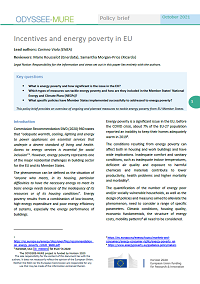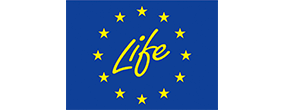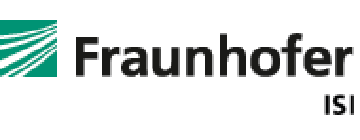Summary
Key questions
- What is energy poverty and how significant is the issue in the EU?
- Which types of measures can tackle energy poverty and how are they included in the Member States’ National Energy and Climate Plans (NECPs)?
- What specific policies have Member States implemented successfully to addressed to energy poverty?
This policy brief provides an overview of ongoing and planned measures to tackle energy poverty from EU Member States.
Lead authors: Corinna Viola (ENEA)
Reviewers: Marie Rousselot (Enerdata), Samantha Morgan-Price (Ricardo)
Introduction
Commission Recommendation SWD (2020) 960 states that “adequate warmth, cooling, lighting and energy to power appliances are essential services that underpin a decent standard of living and health. Access to energy services is essential for social inclusion”1. However, energy poverty represents one of the major residential challenges in building sector for the EU and its Member States.
The phenomenon can be defined as the situation of “anyone who meets, in its housing, particular difficulties to have the necessary energy to meet its basic energy needs because of the inadequacy of its resources or of its housing conditions”. Energy poverty results from a combination of low-income, high-energy expenditure and poor energy efficiency of systems, especially the energy performance of buildings.
Energy poverty is a significant issue in the EU; before the COVID crisis, about 7% of the EU-27 population reported an inability to keep their homes adequately warm in 20192.
The conditions resulting from energy poverty can affect both in housing and work buildings and have wide implications. Inadequate comfort and sanitary conditions, such as inadequate indoor temperatures, deficient air quality and exposure to harmful chemicals and materials contribute to lower productivity, health problems and higher mortality and morbidity3.
The quantification of the number of energy poor and/or socially vulnerable households, as well as the design of policies and measures aimed to alleviate the phenomenon, need to consider a range of specific parameters. Climatic conditions, housing quality, economic fundamentals, the structure of energy costs, mobility patterns4 all need to be considered.
Energy poverty measures in the NECPs
Member States with high levels of their populations living in energy poverty must include an indication of objectives, relevant policies and measures that will contribute to alleviate the problem in their NECPs as requested by EC in the Regulation on the governance of the energy union and climate action (EU)2018/19995.
Therefore, energy poverty poses an important and urgent challenge for national Governments. The issue’s economic and environmental implications require a cross-sectoral approach. This need emerges from the connections among objectives and the need for both social and environmental policies and measures. It also calls for a combination of public policies that correlate energy efficiency deployment to social protection, with particular attention to inequalities.
In the NECPs submitted to the European Commission (27 Countries plus three Regions of Belgium), there are many types of ongoing and planned measures to tackle energy poverty (Figure 1):
- Social and welfare policies and incentives.
- Measures against disconnections.
- Energy allowances and/or reduced prices of electricity and natural gas tariffs.
- Energy Efficiency Obligation Schemes (EEOS).
- Subsidies, rolling fund, financial instruments and incentives for building renovation.
- Information and awareness measures.
- Specific programme/action plan against energy poverty.
- Other support measures.
As shown in Figure 1, “Subsidies, rolling fund, financial instruments and incentives for building renovation” are the most represented, followed by “Social and welfare policies and incentives”.
Figure 1: Number of different types of measures in the NECPs
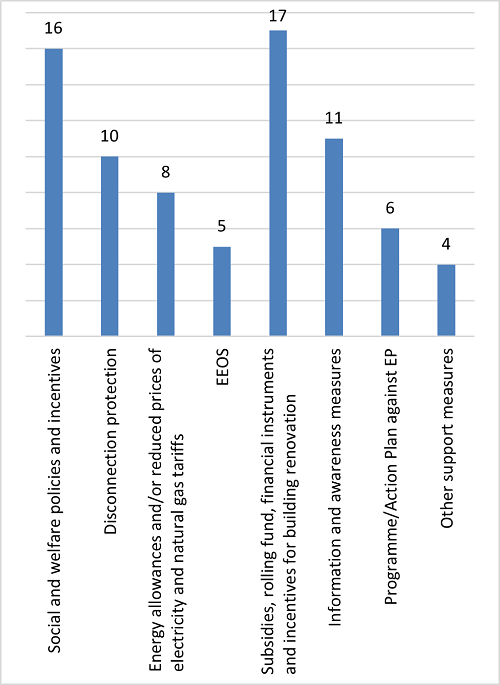
Source: Elaboration ENEA from NECPs (2020)6
Figure 2 shows how many of the abovementioned types of measures are described in each of the Member States’ NECPs.
The main types of measures selected by the Member States to alleviate energy poverty are/will be:
- Social and welfare policies and incentives (53%).
- Subsidies, rolling funds, financial instruments and economic incentives for building renovation (for example for upgrading energy efficiency of buildings, installation of smart meters and/or photovoltaic systems, etc.) (57%).
- Information and awareness measures (37%).
- Disconnection protection (10%).
Figure 2: Numbers of different types of measures in the Member States’ NECPs
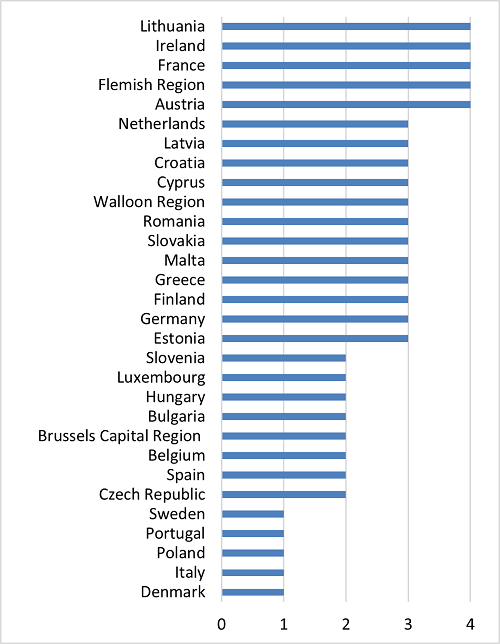
Source: Elaboration ENEA from NECPs (2020)2
In this next section, successful examples from Member States of incentives tackling energy efficiency and energy poverty are presented. These fit into three broad categories:
- Energy Efficiency Obligation Schemes (EEOSs).
- General incentives schemes.
- Specific incentives schemes.
Energy Efficiency Obligation Schemes (EEOSs)
France - White Certificates
The LTECV ("Loi de transition énergétique pour la croissance verte") sets a specific energy efficiency obligation on energy suppliers to achieve energy savings to benefit households suffering from fuel poverty (determined based on household income)7. The foreseen energy saving target (150 TWhcumac8) of the first accounting period (2016-2017) was achieved. Given the successful result of the first period, the fuel poverty requirement for 2018-2020 WCs was increased to 1,600 TWhcumac. As a result of the obligations, more than EUR 2 billion have been invested by the energy companies in the prevention of fuel poverty. A forthcoming decree should extend the target to 2,133 TWhcumac for the 2018–2021 period9.
Ireland - EEOS
The Energy Efficiency Obligation Scheme (EEOS) was introduced in Ireland in 2014 and required all energy suppliers with annual sales above 600GWh to support energy efficiency savings of 550GWh per annum through measures that have direct, short-term but enduring effects on households in energy poverty, e.g., roof insulation, window replacement, external door replacement, high efficiency boilers10. These energy efficiency savings are split across sectors, including savings in the non-residential (75%), residential (20%) and energy poverty (5%)11.
General Incentive Schemes
Italy - Tax deductions for energy renovation of existing buildings (Ecobonus and Superbonus)
Since 2007, under the Ecobonus, residents who invest in energy efficiency actions carried out on the common parts of social housing buildings receive tax deduction rates equal to 70%-75%. Measures aiming at improving the overall winter and summer energy performances of the building can claim the maximum amount of 75% for.
Following the COVID-19 pandemic, to give an important boost to the economy, the Italian government launched the Superbonus, where the tax deduction rate for some energy efficiency and anti-seismic actions to 110% of the incurred expenditure12. Furthermore, it facilitates the mechanism of credit assignment and invoice discount.
The tax credit can be assigned to credit institutions and financial intermediaries also. These possibilities can help both energy poor households and social housing bodies to renovate their homes.Poland - Clean Air and Stop Smog Programmes
The ‘Clean Air’ programme provides grants to reduces costs of construction materials, equipment and services incurred in connection with a thermos-modernisation and renovation project in single-dwelling buildings.
The ‘Stop Smog’ programme is targeted at energy poor households living in single-dwelling buildings. The programme is addressed to all municipalities that can prove poor air quality in their territory. The programme covers the following actions, carried out by the municipality and financed from public funds up to 100% of their value:
- Replacement of heating devices or systems with those compliant with low-emission standards.
- Removal of heating devices or systems and connection to the district heating, electricity or gas network.
- Comprehensive building thermos-modernisation (e.g. insulation and more efficient heating systems).
The programme is currently planned to run in 2019-2024 and its total budget (comprising the State’s and local governments’ contributions) amounts to PLN 1.2 billion (approximately EUR 265 million).
Slovakia - Legal laws against energy poverty
A number of binding legal norms are in place that create the conditions to tackle energy poverty:
- Act N.443/2010 on subsidies for the development of housing and on social housing, providing grants for the elimination of systemic defects in apartment buildings. They may be used for the acquisition of an apartment lease for the purpose of social housing, for acquisition of technical equipment, removal of a system failure related to the living in the social housing.
- Act N.150/2013 on the State Housing Development Fund provides loans for the insulation of existing apartment buildings. These loans are granted for the following purpose13:
- Act N.443/2010 on subsidies for the development of housing and on social housing, providing grants for the elimination of systemic defects in apartment buildings. They may be used for the acquisition of an apartment lease for the purpose of social housing, for acquisition of technical equipment, removal of a system failure related to the living in the social housing.
- Procurement of rental housing for vulnerable members of society.
- Construction and purchase of apartments into private property of natural persons.
- Undertake complex renovation works of residential buildings.
- Construction and renovation of social housing.
In addition, in Slovakia the ‘State Housing Development Fund’ provides non-repayable grants or favourable loans to improve the thermal insulation of residential buildings and apartments and it is addressed to individuals, households and associations of owners.
Specific Incentive Schemes
Ireland - Targeted measures against energy poverty
The policy-mix against energy poverty in Ireland embodies the following ongoing measures:
- The Better Energy Warmer Homes Scheme is aimed at lower income households and provides grants to help to increase the energy efficiency and warmth of homes, including grants for deeper measures and heating upgrades.
- The Better Energy Communities Scheme supports lower income households to improve energy efficiency of homes.
- The Warmth and Wellbeing pilot scheme for energy efficiency home upgrade supports people with severe respiratory conditions also belonging to lower income groups.
- The Local Authority housing upgrade programme aims to upgrade the social housing stock.
- The Housing Assistance for Older People scheme supports older people to improve the living conditions of their home, including insulation and heating upgrades.
- The Housing Adaptation Grant for People with a Disability provides grants for works in dwellings that must be adapted to the needs of people, in particular for a person with a physical, sensory or intellectual disability or a mental health difficulty.
ODYSSEE-MURE indicators
The ODYSSEE-MURE project developed indicators to measure Multiple Benefits (MBs) of energy efficiency. Within social-related MBs, health aspects, poverty alleviation and employment are considered. For energy poverty the indicator "Impact of savings on energy cost shares in household income (fuel poor households)" shows the impact of energy efficiency in low-income households on the absolute and relative energy cost as part of the disposable income.
The Figure 3 shows the percentage of energy cost saved as share of disposable income compared to 2000 for the considered countries. Two different methods of evaluation are applied: Top-Down (TD) figures are based on savings calculated from the energy statistics of the ODYSSEE database; the Bottom-Up (BU) results refer to the policy evaluations from the MURE database.
Figure 3: Impact of savings on energy cost shares in household income (fuel poor households)
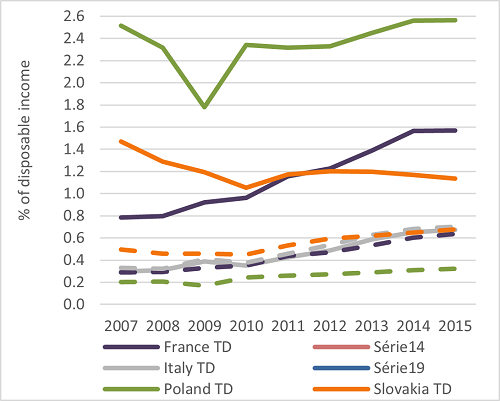
Source: ODYSSEE-MURE
BU evaluations show how implemented programmes are becoming more effective in the years, with a higher share of saved energy costs on the disposable income.
Conclusions
TD and BU lines for the indicators developed within the ODYSSEE-MURE project are very separate in Figure 3. This shows how challenging is the assessment of energy poverty yet. The timely availability of more precise data on both disposable income and energy consumption of fuel poor households is crucial to effectively support policymakers in the monitoring of the phenomenon, and the set-up of policies and programmes able to alleviate it. To this aim, the sharing of measures such as those of this policy brief may be a source of inspiration to successfully adapt and replicate them in other contexts.
Notes
- 1: https://ec.europa.eu/energy/sites/ener/files/recommendation_on_energy_poverty_c2020_9600.pdf
- 2: Eurostat, SILC [ilc_mdes01] for EU27 in 2020
- 3: https://ec.europa.eu/energy/topics/markets-and-consumers/energy-consumer-rights/energy-poverty_en
- 4: https://www.energypoverty.eu/guidance-policymakers
- 5: https://eur-lex.europa.eu/legal-content/EN/TXT/PDF/?uri=CELEX:32018R1999&from=EN
- 6: https://ec.europa.eu/energy/topics/energy-strategy/national-energy-climate-plans_en#final-necps
- 7: Loi n° 2010-788 du 12 juillet 2010: https://www.energypoverty.eu/news/fuel-poverty-france
- 8: The term "cumac" corresponds to the contraction of "cumulative" and "actualized". https://www.ecologie.gouv.fr/dispositif-des-certificats-deconomies-denergie
- 9: https://ec.europa.eu/energy/sites/ener/files/documents/fr_final_necp_main_en.pdf
- 10: The Redesign of Ireland’s EEOS - April 2021 https://www.svp.ie/getattachment/7b5e5816-ee3a-43d1-b1c3-573d1f1616a5/SVP-Submission-to-EEOS-2021.aspx
- 11: https://e3p.jrc.ec.europa.eu/sites/default/files/files/documents/Presentations/08_mr._cleary_eeos_in_ireland.pdf
- 12: Law Decree of May 19, 2020 n. 34 ("Decreto Rilancio").
- 13: https://www.fi-compass.eu/sites/default/files/publications/Kollarova.pdf
